We all know pitcher plants trap bugs and digest them for nutrients. We are all wrong. Sort of.
It turns out that although pitcher plants do indeed trap insects (and other small animals!) to make up for the lack of nitrogen in their nutrient-poor soil, they often don't digest their prey all by themselves. In many pitcher plants, and particularly the purple pitcher plant (Sarracenia purpurea), there is a complex, thriving ecosystem responsible for breaking down the preyref.
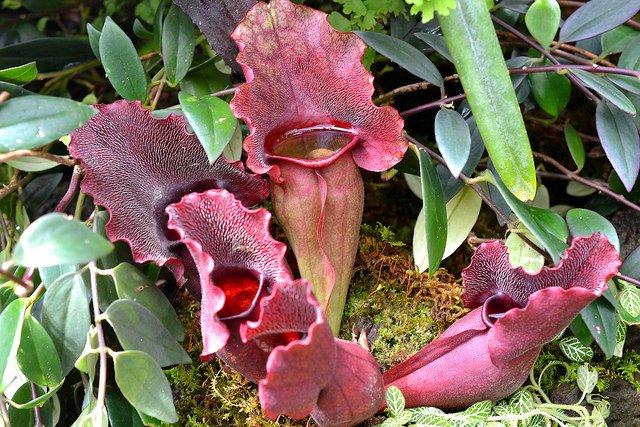
Welcome to the pitcher plant! Come for the nitrogen, stay for the community! Source, by incidencematrix under CC2.
Dramatis personae
Pitcher plants
Let's start with the host for the whole shebang. The purple pitcher plant grows in boggy soil and needs nitrogen. To do this, it forms cup shaped leaves that fill with water (a kind of phytolema) and attracts insects with nectar. The insects, attracted to the sweet, sweet nectar, get trapped in the cup by means of (depending on the kind of plant) sticky walls, downward facing hairs, canopy lids, or even thin roof patches that let light in and act as 'decoy exits'.
The general view used to be that the pitcher plants secreted various enzymes to break down their prey, but we know now that some pitchers, such as our model purple pitcher, only secrete a small amount in the first few weeksref of a cup's useful lifetime - most cups last about a year and die-off during the winter.
Bacteria

Source, by Josef Reischig under CC3
If an environment provides a way to live, you're probably going to find bacteria or archaea in it. The pitcher's phytolema is no exception - even in the rare cases where a pitcher species does not contain large residents (macrobiotic infauna), I wouldn't be surprised if there were microbes hanging about.
As best we can tell, there's no real 'core' bacterial community inside the pitcher.ref It's just a random collection of generalist heterotrophs doing what generalist heterophs do: breaking down food into CO2 and organic nitrogen (mineralization).
Rotifers, ciliates, and other protozoa
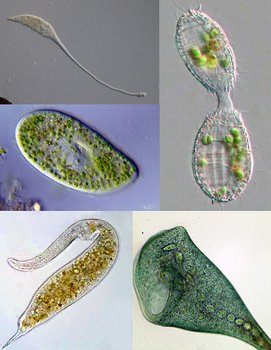
Source, components by Picturepest, Anatoly Mikhaltsov, Bernd Laber, Deuterostome, Flupke59, all under CC4.
Although physiologically interesting and often the stars of middle-school 'pond water microscopy', these are often the red-headed stepchild of microbial ecology. Lots of researchers generally just mention that they 'graze on bacteria' and move on. That's pretty much the case here, but there's one of group of protists which are getting some attention.
Colpodea colpodida is one of the protozoa found in pitchers and it can serve as a food source for mosquito larvae (more on those in a moment). However, other protozoa which move about more freely are more attractive targets to the mosquito larvae and when they are present, C. colpodida doesn't get eaten nearly as often. What's cool is that the genes expressed by C. colpodida are directly correlated to how much the mosquito larvae attack them - providing a nice little system for looking at ecosystem-influenced genetic expression in populations.
Mosquito larvae
One of the most influential infauna members in a pitcher is a mosquito, specifically the larvae of Wyeomyia smithii. Not only is W. smithii considered to be a keystone species in the pitcherref, but the pitcher is supremely important to the mosquito, too. The larvae of W. smithii are only found in pitcher plants (obligate relationship); no pitchers means no W. smithii. In th pitcher plant world, fauna with this type of relationship are referred to as nepenthebionts, with the 'nepenthe' root coming from the genera of another popular pitcher.
So, what's so important about the pitcher to our mosquito friend? Simply, it's an amazing food source - the larvae are filter feeders and are capable of eating a lot of what's in the pitcher. They don't just limit themselves to the broken down parts of the pitcher's prey, they also eat the bacteria and protists I've already mentioned.
Midge larvae
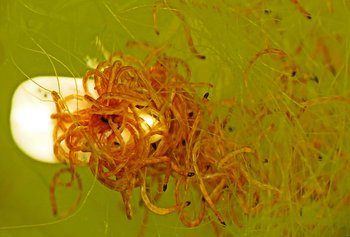
Source, by Martin Cooper, under CC2.
The other important nepenthebiont, Metriocnemus knabi is larva of a midge which has been described as "ravenously carnivorous". Like the mosquito larvae, they also eat the unfortunate prey of the pitcher. Interestingly, both the midge and mosquito larvae can exist in the same pitcher, despite (at first glance) competing for the same food.
They get along so well, in fact, that M. knabi larva won't even attack W. smithii larva, but they do attack the larva of other mosquitos. Clearly, there's some interesting ecological relationships going on in all this, but I want to highlight one more organism before we get into that.
Crabs
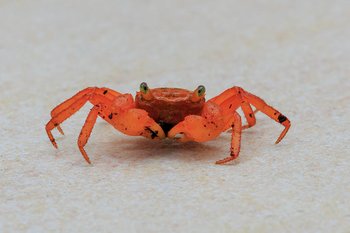
Source, Photo by CEphoto, Uwe Aranas, attributed as per the CEphoto terms under CC3
Yes. That's right, crabs! I was completely unaware that crabs lived in some pitchers until I started reading more deeply to prepare this article. So, first off, I should mention they are more strongly associated with other pitchers than our purple protagonists, but it is too cool to not mention that there are crabs (Geosesarma malayanum) in Malaysia which regularly raid pitchers for food. Unlike the midges and mosquitos, they are not obligately dependent, so they are considered nepenthephiles, not nepenthebionts.
There is not a good copyright-free image of these little crustaceans, but Francesco Tomasinelli has taken some really cool snapshots of them in pitchers which you should check out. (The picture above is a related species in the same genus.)
More relationships than a Jane Austen novel
Right, so an ecosystem consists the the environment, the organisms which inhabit it, and the relationships between those organisms. Not counting our cool little Malaysian crab but including the prey, there are six organisms involved, leading to 15 potential relationships for just nitrogen flow - and that's not even accounting for things like changes over time including the differences between 'partially chewed prey' and 'freshly caught prey'.

What kind of relationships are we looking at
You might remember terms like mutualism, symbiosis, and parasitism from science class. These are all examples of the forms these relationships may take. It turns out that there's a lot of these terms which can differ finely in shades of meaning (e.g. is it commensalism or just very lopsided mutualism?). Others can depend on how important it is to capture certain details - such as how resources are shared (e.g. syntrophy vs. processing based commensalism). To be clear here, let's stick to the basics relevant to our ecosystem and define our terms:
- mutualism: both organisms benefit
- commensalism: one organism benefits, the other is unaffected
- competition: both organisms require the same resource
- predation: one organism eats the other, for simplicity, I'm considering bacterial use of substrate as predation
In the purple pitcher plant, this is how it breaks down:
- The pitcher plant itself predates on the hapless prey, but it's not very good at breaking them down
- Bacteria decompose whatever is dead inside the pitcher, the smaller the surface area the better
- Midges predate on the prey, chewing up large chunks of the prey, making tiny particles
- The bacteria are happy because this means that there's more surface area to eat away at and to grow upon (commensalism)
- The rotifers and other protozoa predate upon the bacteria
- The mosquito larvae predate upon the bacteria, rotifers, and chewed up bits of prey
- Since the mosquitoes don't eat up the unchewed prey, they are not in actual competition with the midges. If fact, this is a form of processing chain commensalism
- The bacteria both benefit from the mosquito larvae removing their predators and suffer from being eating by the larvae.
- All of the infauna are dying, and excreting waste, notably nitrogen, which the plant can absorb (commensalism). The larvae eventually become adults as fly away, taking the nitrogen in their body with them (competition)
The questions then, are, how do all these interactions work together, are they ultimately good or bad for the pitcher, and under what conditions does that change?
The short answer is that it all depends. The longer answer to this is that nobody's really quite sure and reasonable people have disagreed in the literature. An even longer answer lies in the idea that we can simulate all these interactions.
On models and experimentation
Some researchers have made a somewhat simplified computer model (in silico) and let it run with different population amounts to determine when and how each species benefits (or doesn't) from the othersref.
According to their model, the pitcher actually does best when there are only bacteria present. That condition may be a mathematical maximum, but it is hardly realistic in a real bog. When other species are present, they show that things eating bacteria is bad (as we might expect) and that the mosquito levels have a sort of hump shape where whether or not they benefit the plant depends on their amount and the amount of detritus within the pitcher.
I also particularly like that in their conclusions they say that interactions are predominantly parasitic or mutualistic, emphasizing that these things are on a spectrum and not the clear cut relationship presented in so many texts.
Now, let me show you a picture then ask you a question.

The above is the schematic for the model used in the simulation. You definitely don't need to understand all of it, but I'd like you to look at the arrow between bacteria and protozoa. The part that says upBP is a parameter expressing how fast bacteria are consumed by protozoa, given their two population sizes. For the model to be run, that parameter and all the others have to be set to numbers. How do you pick the number? Experiments!
One great thing about purple pitchers is that they are tiny little ecosystems (microcosms) that're pretty easy to maintain, can be grown up in sterile conditions, and are (insofar as carnivorous plants go) easy to cultivate. It's actually possible to experimentally control the relative populations in these systems and figure out what those parameters areref. One of the great things about science is that you don't have to do it all, you can build on the work of others. And that is exactly what Mouquet did - they used existing experimental data from the literature.
Conversely, you can run the models with parameters and compare them to your experimental systems to validate your model. A note to all the budding ecologists out there - it's a BIG no-no to derive your parameters and validate your models from the same data. Do you want confirmation bias? That's how you get confirmation bias.
Why care
First of all, I'm going to assert that you should care simply because this is a cool system. It doesn't have to have any other value than itself. However, if you insist on a bigger picture, there's a whole slew of reasons to care, ranging form the the practical to philosophical.
At the most practical, pitcher plants are easily experimentally controlled complex ecosystems. Beyond exploring them for their own sake this makes them a great model system for exploring ecology. If, for example, you're interested in the effect of secondary predation upon the primary decomposers in a food web, this is perfect.
Apart from the direct food web questions, these systems are still incredibly useful practical models. For example, you can stress them out environmentally or population-wise to determine when and how different tipping points occur in the ecosystem. You can then extrapolate those results to other, less manageable ones.
I am particularly enamored with this set of quotes from Aaron Ellison, who studies environmental changes in lakes. "We would need to study a lake for 100 years to get the same information that we can get from a pitcher plant in less than a week" and "The same mathematical models can be used to describe either a pitcher plant ecosystem or a lake." (emphasis mine). This is the whole point of a model system. At the right level of abstraction, the math is the same; A model system lets you work with the same ideas more easily, economically, ethically, and/or rapidly.
Even without acting as models, these little plants can change the way we think about things. I hope by now you're convinced that the ecosystem they contain, while manageable, is complex and unpredictable. It may even seem a bit like hubris to assume you could easily predict what would happen if you altered the system.
Those of you who follow @steemstem may be aware of the really nice pair of articles in which @bitfairy laments the existence of mosquitos and @mountainwashere responds with some counterpoints.†
The upshot is that removing mosquitoes has a lot of benefits, but also has a lot of (probably unpredictable) ecological side effects. The complexity of our little pitcher plant ecosystem is a humbling reminder of that. What do you think might happen to the pitcher population if you killed off all our W. smithii mosquitos? I am not sure, myself, but given that W. smithii is generally believed to benefit the pitchers, I suspect they would undergo a big die-off.
First, this would be lamentable on its own - the loss of biodiversity is always something saddening, but even more so when it involves such unique ecosystems and methods of living. Second, if you're not into the whole biodiversity-for-biodiversity's sake thing, let me tell you that pitcher plants may have some medicinal value and certainly have been used to make tasty cocktails.
Venturing even beyond those abstractions, this system can serve as an analogy for philosophical reasoning. I was inspired by @ced000's article using thermodynamics as analogy to understand STEEM. One of the big, perennial questions facing our community is how do various actions and types of users affect the health of the blockchain (And how do you define health anyway?).
I have to imagine that a better understanding of ecology can inform our understanding of community (and vice-versa!). The same tools we used to think about mosquitos and pitcher plants can help us ask and answer questions like 'are bidbots parasitic or commensal?' Or, how do you increase minnow retention in a way such that they benefit the blockchain? Does that make sense, or am I nuts?
†.Really cool things happen when articles are written as responses to each other. More of this please!
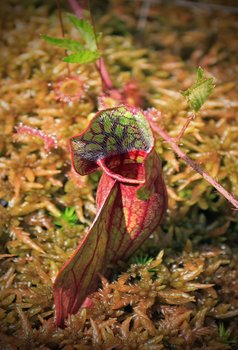
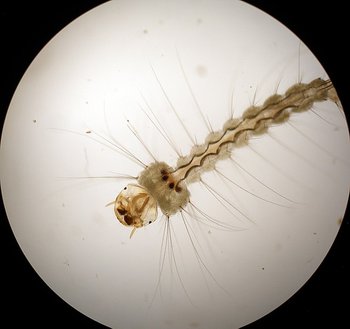
Solid work. I should have known bacteria helped break down things, but protozoa, larvae, and even crabs are unexpected. I also learned one of the first concrete reasons why mosquitoes are ecologically important.
Oh, and protozoa being the stars of middle school microscopy, but the red-headed stepchild of microbiologists is probably the most perfect explanation of them I've ever heard.
Downvoting a post can decrease pending rewards and make it less visible. Common reasons:
Submit
Glad you liked it. I was a little worried about the red-headed stepchild observation, happy someone agrees.
Downvoting a post can decrease pending rewards and make it less visible. Common reasons:
Submit
This was a great read, @effofex. I as not familiar with the complex ecosystem found in this pitcher plant, so I certainly learned something new. It never occurred to me that there could be a species of mosquito who depended on this plant.
Downvoting a post can decrease pending rewards and make it less visible. Common reasons:
Submit
I actually had no idea either about the mosquito. I initially got interested in the topic when a colleague mentioned that purple pitchers are extremely low in digestive enzymes and that the microbial community is important. It just got more and more interesting the more I read.
Downvoting a post can decrease pending rewards and make it less visible. Common reasons:
Submit
It seemed like a very interesting rabbit hole to go into!
Downvoting a post can decrease pending rewards and make it less visible. Common reasons:
Submit
Just so long as I don't end up getting trapped and digested. ;)
Downvoting a post can decrease pending rewards and make it less visible. Common reasons:
Submit
Well, it would make for interesting news to see a human being consumed by a carnivorous plant :P
Downvoting a post can decrease pending rewards and make it less visible. Common reasons:
Submit
Or at least a nice musical...
Downvoting a post can decrease pending rewards and make it less visible. Common reasons:
Submit
That makes perfect sense. You are cursed (blessed) with a 'big picture' view of the universe of life. Anything viewed in isolation yields information--viewed in a large context, it yields insight. Ecology is an interesting word. To some it refers to specific aspects of 'nature' (then again, nature is an interesting word also). But ecology, as you consider it here, refers to a system, with complex, not always clearly understood relationships and connections. It is hubris to believe we can foresee the consequences of messing with one small part of the system. Results are unpredictable, and sometimes catastrophic.
Also, I too thought of the mosquito debate, when I read your blog. I still regard mosquitoes with loathing, and yet recognize their "right" to exist, perhaps the necessity of their existence. But even as larvae these guys are parasitic. In the whole universe of creatures, these are among my least favorite.
A really good blog. As I prepare to write another, yours sets a model for how detailed, and readable, a blog should be.
Downvoting a post can decrease pending rewards and make it less visible. Common reasons:
Submit
I'm glad you liked it so much. I'm very much an abstractive thinker - I blame too many years of coding for doing that to my brain.
Downvoting a post can decrease pending rewards and make it less visible. Common reasons:
Submit
I never coded, and I tend to see relationships between things--I think my training in comparative literature pushed me further in that direction.
Downvoting a post can decrease pending rewards and make it less visible. Common reasons:
Submit
I never thought about it, but I can definitely see how that skillset would also lead to better abstraction.
Downvoting a post can decrease pending rewards and make it less visible. Common reasons:
Submit
Thank you for your contribution. Dont forget to link references and sources when applicable!
=======================================================================================
This post was upvoted and resteemed by Steemgridcoin with the aim of promoting discussions surrounding Gridcoin and science.
This service is free. You can learn more on how to help here.
Have a nice day. :)
Downvoting a post can decrease pending rewards and make it less visible. Common reasons:
Submit
Great article. Well done!
Downvoting a post can decrease pending rewards and make it less visible. Common reasons:
Submit
Glad you liked it.
Downvoting a post can decrease pending rewards and make it less visible. Common reasons:
Submit
Congratulations! This post has been chosen as one of the daily Whistle Stops for The STEEM Engine!
You can see your post's place along the track here: The Daily Whistle Stops, Issue #158 (6/7/18)
The STEEM Engine is an initiative dedicated to promoting meaningful engagement across Steemit. Find out more about us and join us today.
Downvoting a post can decrease pending rewards and make it less visible. Common reasons:
Submit
Awesomesauce!
Downvoting a post can decrease pending rewards and make it less visible. Common reasons:
Submit
"I eat flies with a little help from my friends" -- ???
That title alone is worth showing off.
Downvoting a post can decrease pending rewards and make it less visible. Common reasons:
Submit
I'm so glad that title tickled someone, I felt pretty proud coming up with it.
Downvoting a post can decrease pending rewards and make it less visible. Common reasons:
Submit
Fascinating! I would never imagine how complex an ecosystem could exist inside a single plant.
Downvoting a post can decrease pending rewards and make it less visible. Common reasons:
Submit
I understood the basics of association back then, you just took it to a whole new realm, a higher one. Excellent explanation!
Downvoting a post can decrease pending rewards and make it less visible. Common reasons:
Submit
I think it's a bad idea to always live by assumption that we know something when we don't even Know at all. To anyone that care to read this post, will get to understand the ecosystem existing inside the pitcher plant erroneously believed to kill all insects flying into it. If I had know this along time I would not be among those that claim otherwise. But I think the ecosystem existing inside the cup is a bit complex. Thanks @effofex for this wonderful post.
Downvoting a post can decrease pending rewards and make it less visible. Common reasons:
Submit
Hi @effofex!
Your post was upvoted by utopian.io in cooperation with steemstem - supporting knowledge, innovation and technological advancement on the Steem Blockchain.
Contribute to Open Source with utopian.io
Learn how to contribute on our website and join the new open source economy.
Want to chat? Join the Utopian Community on Discord https://discord.gg/h52nFrV
Downvoting a post can decrease pending rewards and make it less visible. Common reasons:
Submit
arrgggh! :)
I was a bit astonished to read that the pitcher plant model could be used to describe a lake. This is just... wow :)
And by the way, thanks for shedding light on so many steemians :)
Downvoting a post can decrease pending rewards and make it less visible. Common reasons:
Submit
I have to admit to be particularly proud of that caption.
Yep. As long as the math is the same, different model systems can be much more useful than the actual ecosystem you're looking at. Even more fun is when there's a few bits of the model system which cannot describe the the actual system. It's a big flag saying 'this is an important distinguishing characteristic'.
Happy to do so, I'm pretty sure my opinion on the importance of interaction for communities is apparent, and it's easy to mention other steemians when they're making really interesting posts.
Downvoting a post can decrease pending rewards and make it less visible. Common reasons:
Submit
The striking thing here was that the same model was working for so unrelated objects. But in terms of the ecosystem, not that different :)
That is the most exciting part, as a scientist: one needs to improve the model ^^
Downvoting a post can decrease pending rewards and make it less visible. Common reasons:
Submit
I'm not surprised you agree - your field is perhaps one of the cleanest examples of this put to use.
Downvoting a post can decrease pending rewards and make it less visible. Common reasons:
Submit
:)
Downvoting a post can decrease pending rewards and make it less visible. Common reasons:
Submit
I've been off line for a while with discord. Just saw this post and had t o respond. I have always been fascinated with Carnivorous plants and have been meaning to start a collection of them. I had bought some seeds once but nothing grew. How can I get some hardy pitchers, sundews and Venus fly traps as well as other such plants?
Downvoting a post can decrease pending rewards and make it less visible. Common reasons:
Submit
I have to admit, I looked into growing them during my research. It's very tempting.
As I understand it, the best way to go with pitchers is to propagate them by transplanting some rhizome. You've got (I assume) lots of sun in Roswell, so the big things for you would be keeping them at the right humidity, pH, and low mineral content. Tom's Carnivores looks like a really nice guide.
Downvoting a post can decrease pending rewards and make it less visible. Common reasons:
Submit
You received a 80.0% upvote since you are a member of geopolis and wrote in the category of "geopolis".
To read more about us and what we do, click here.
https://steemit.com/geopolis/@geopolis/geopolis-the-community-for-global-sciences-update-4
Downvoting a post can decrease pending rewards and make it less visible. Common reasons:
Submit
Excellent post that got me increasingly interested and informed about a topic I first thought was interesting, then learned it was far more complex than I imagined!
Downvoting a post can decrease pending rewards and make it less visible. Common reasons:
Submit
Glad you liked it.
Downvoting a post can decrease pending rewards and make it less visible. Common reasons:
Submit
Did you see this post about biochemical factors in insectivorous plants?
https://steemit.com/steemstem/@davidrhodes124/insectivorous-plants-part-4
Downvoting a post can decrease pending rewards and make it less visible. Common reasons:
Submit
Absolutely, I'm a big fan of @davidrhodes124's posts.
Downvoting a post can decrease pending rewards and make it less visible. Common reasons:
Submit
Loved the whole of it, but especially the 'why care' section, as you're spot on on everything you say there even though it's more subjective than the rest of the article.
While reading I too was thinking a pitcher is like a lake. And also like a mammal's digestive system but maybe without all the drama, although flies do leave our mouths in bulk too sometimes, e.g. in Mummy movies.
Oh and that crab...it's basically occupying the whole niche! It made a glorified seashell out of that pitcher!
Downvoting a post can decrease pending rewards and make it less visible. Common reasons:
Submit
I really enjoy writing the 'why care' style sections. In fact, while it's not a deliberate criteria, I think I usually hold off on writing about a topic until I have some idea of how to answer that question. I'm glad you especially liked it.
It's very much like those systems, biologically they're all 'islands' and island biogeography is one major interest of mine.
Yeah, the crab is ridiculous. Some of its close cousins look really cool and are apparently neat pets, too.
Downvoting a post can decrease pending rewards and make it less visible. Common reasons:
Submit
Super cool! I thought I knew a thing or two about pitcher plants, but I learned some stuff. Thanks for the cool info!
Downvoting a post can decrease pending rewards and make it less visible. Common reasons:
Submit
Hey does first photo is taken by your camera?
This is really awesome.
You wrote it very well. Your writing and knowldege is awesome.
thanks
Downvoting a post can decrease pending rewards and make it less visible. Common reasons:
Submit
I'm glad you liked it. Sadly, none of the photos are my own.
Downvoting a post can decrease pending rewards and make it less visible. Common reasons:
Submit
Thanks...
Downvoting a post can decrease pending rewards and make it less visible. Common reasons:
Submit
This is a really great read. Long but interesting. Who knew so many microbes and even crabs live in these pitchers! Thanks for putting in so much effort to put together this post.
Downvoting a post can decrease pending rewards and make it less visible. Common reasons:
Submit
I wanted to express my gratitude for your posts by including it in my series, Biomimicry Inspirations: showcasing the principles and biology of nature without getting lost in the science. For biomimics, circular economists, circular designers, urban planners, architects, process managers, and all nature-based professionals!
Downvoting a post can decrease pending rewards and make it less visible. Common reasons:
Submit
What a cool project! Honored to be included. I'll be following with interest.
Downvoting a post can decrease pending rewards and make it less visible. Common reasons:
Submit